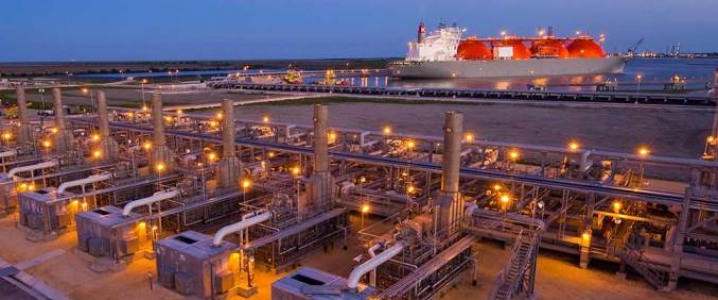Donald Trump’s trade war with China is starting to scare away oil and gas investments, as new trade barriers clouds the long-term outlook on exports.
Australia LNG announced that it would delay a final investment decision on its Magnolia LNG plant in Louisiana until next year, citing trouble securing enough buyers in China. “We remain confident in our ability to reach (final investment decision) on Magnolia whether or not China participates,” CEO Greg Vesey said in a tweet, before arguing that “multiple opportunities with customers in Europe and Asia exist, and our discussions with them are proceeding well.”
His company might still move forward, but will need to find buyers elsewhere because the U.S.-China trade war shows no signs of abating, at least as of now. The Trump administration has implemented two rounds of tariffs on China. The first round consisted of about $50 billion in tariffs on Chinese goods, which was followed by a much more dramatic 10 percent tariff on $200 billion in imports from China. That 10 percent tariff is set to jump to 25 percent at the end of the year.
A possible third and even more dramatic round is still in the cards, which would hit an additional $257 billion in Chinese goods. That would be even more significant because it would amount to just about the entirety of U.S. imports from China and would hit a broader set of consumer goods, and its effects would be felt across U.S. society as everyday items would likely see price increases.
However, as it relates to the oil and gas market, the effects of the trade war are already evident. China retaliated to U.S. tariffs a few months ago by slapping a tariff on U.S. LNG. Without a clear path towards resolution, LNG developers cannot move forward with investment in new export terminals. Related: The Clock Is Ticking: How Much Oil Will Iran Lose?
China is at the center of all global growth forecasts for LNG. The pace of Chinese demand for LNG largely determines the pace of global LNG demand growth. Chinese demand will also heavily influence prices, and thus, project economics, for the next decade or so. Any hiccup in Chinese demand will reverberate in gas markets around the world. The previously anticipated glut in LNG, and the recent tightness, all comes down to faster-than-expected imports of LNG into China.
As a result, a tariff on U.S. LNG into China upends the economics of any LNG export terminal within the United States.
A few weeks ago, Royal Dutch Shell gave the greenlight on a massive LNG export terminal on Canada’s pacific coast. The move was made with the tightening market for LNG in mind, but also with a clear eye on China. Critically, however, Shell does not have to worry about tariffs. Developers in the U.S., on the other hand, do.
The delay of an FID on Australia LNG’s Magnolia project in Louisiana is the clearest sign yet that the U.S.-China trade war is slowing investment. “Chinese LNG demand growth is the largest piece of demand growth out there, and Chinese buyers have got to feel reluctant to commit to U.S. capacity when the U.S. government sees trade as a means of exerting political leverage,” Bob Ineson, managing director of North American natural gas at IHS Markit, told Reuters.
Industry sources told Reuters that no Chinese company is signing any long-term LNG deal with American exporters until the trade war is resolved. There are at least six other projects that are either under construction or nearing FID decisions, with several more possible in the next few years.
New pipelines still need to connect the shale fields in Alberta and British Columbia to Canada’s Pacific Coast. However, if the region is connected to the coast, then Shell will be able to export large volumes of gas to China. Other regions, including East Africa, Australia and the Persian Gulf are also expanding LNG export capacity.
The delays in the U.S., stemming from Trump’s trade war, could be pivotal. “This conflict could lead to many developers of U.S.-based projects missing this window,” said LNG Canada’s chief executive, Andy Calitz, according to Reuters. U.S. projects could end up “dead in the water,” while smaller LNG projects in Canada may actually move forward. Related: Trade War Puts The Brakes On U.S. LNG Dominance
Meanwhile, the next round of tariffs on China could provoke Chinese tariffs on U.S. crude oil. To date, China has held off on this option. China has increased its purchases of U.S. oil over the past year, but the escalating trade war has also scared away some Chinese companies in recent months. If the Trump administration moves forward with the next tranche of tariffs, Beijing might retaliate with levies on American crude.
“US President Trump has again threatened to slap punitive tariffs on all imports from China. It is hardly conceivable that China would continue in this case to exempt US crude oil imports from its counter-tariffs,” Commerzbank said in a note. “The introduction of a 25% punitive tariff would make US crude oil prohibitively expensive for Chinese consumers and cause demand to shift to other suppliers. New consumers would then have to be found for US crude oil, which would continue to justify a high price discount as compared with Brent.”
This is obviously not any sort of existential threat to oil and gas investments. But, the trade war could put an extra discount on WTI, while also acting as a barrier to investment for LNG projects in the U.S. for the foreseeable future.
By Nick Cunningham of Oilprice.com
More Top Reads From Oilprice.com:
- This High Profile Merger Could Impact EU Gas Markets
- What’s Behind The Continued Selloff In Oil?
- U.S. Oil To Significantly Outperform This Year


















